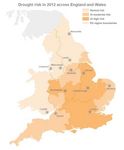Tips to save water
28th February 2012
On Monday 20 February, the Environment Secretary announced that the South East of England has officially moved into drought status. This is due to the combination of persistent dry weather and the continuing decline in groundwater levels and river flows and increasing the risk to public water supplies, agriculture and the environment.
As a result Hampshire, West Sussex, East Sussex, Kent, Surrey, London, Berkshire, Hertfordshire, Buckinghamshire, Oxfordshire, and the east of Gloucestershire are now in drought.
What can you do to help save water during a drought?
To help save water during a drought:
- Ensure taps are turned off. If you spot a leaking tap, tell building maintenance staff.
- Have your windows cleaned less often, as long as it doesn't affect health and safety.
- Clean cars less often which will also save money; but still clean headlights and windows for health and safety reasons.
- Encourage employees to use water wisely at work and home.
- Ask your water company to help identify where you can save water.
- You don't need to be in a drought area to benefit from saving water.
Follow these top tips from Envirowise:
- Don't think of water use and disposal charges as fixed costs. Many companies can save up to half their water costs by implementing simple and inexpensive ways of minimising water use.
- Always monitor how much water you use and compare use on a regular basis. Manufacturing companies should compare water use against production output and service sector companies should compare use against staff numbers.
- Appoint a water monitor to walk round the site regularly to identify ways of minimising water use.
- Make sure staff are fully aware of the importance of water minimisation.
- Ensure pipes are well insulated against frost.
- Check out opportunities for re-using process water.
- Look at alternative water sources such as using rainwater and greywater.
- Keep water-using equipment well maintained and check it periodically for leaks.
- Encourage staff to report leaks and ensure any leaks are repaired quickly.
- When buying new equipment, take its water efficiency into account. Water-efficient equipment may be more expensive, but the water savings it brings may mean it has a short payback period.
- Fit water-minimising controls where possible, e.g. push taps, flow regulator/restrictors, cistern displacement devices, spray nozzles on hoses, low-flush toilets and sensor-activated urinal flushing.
Other ways you can save water at home:
- Wash your car with a bucket. This generally uses less water than using a hose, but do you really need to wash it? Just keep headlights, mirrors and windows clean for safety reasons.
- Don’t let water run to waste while waiting for the water to get hot - collect and use to water plants. You can also collect the running water in the shower before getting in.
- Avoid running the tap until the water runs cold every time you want a drink. Keep a jug of water in the fridge so you always have cool drinking water.
- Let your grass grow – this provides shade for the soil and helps retain water. If your grass goes brown, it doesn’t mean it has died: it will recover when it rains.
- Reuse bath water for house plants or in the garden? You can collect it using a watering can, or buy a simple device to siphon bath water from the bath to the garden.
- Use water saving crystals which expand and hold water in your soil when you water it and when it rains.
Most importantly, think before you use water - ask yourself what the water is for and if you really need to use it.






 Except where otherwise stated, content on this site is
licensed under a Creative Commons Attribution 3.0 License.
Except where otherwise stated, content on this site is
licensed under a Creative Commons Attribution 3.0 License.
